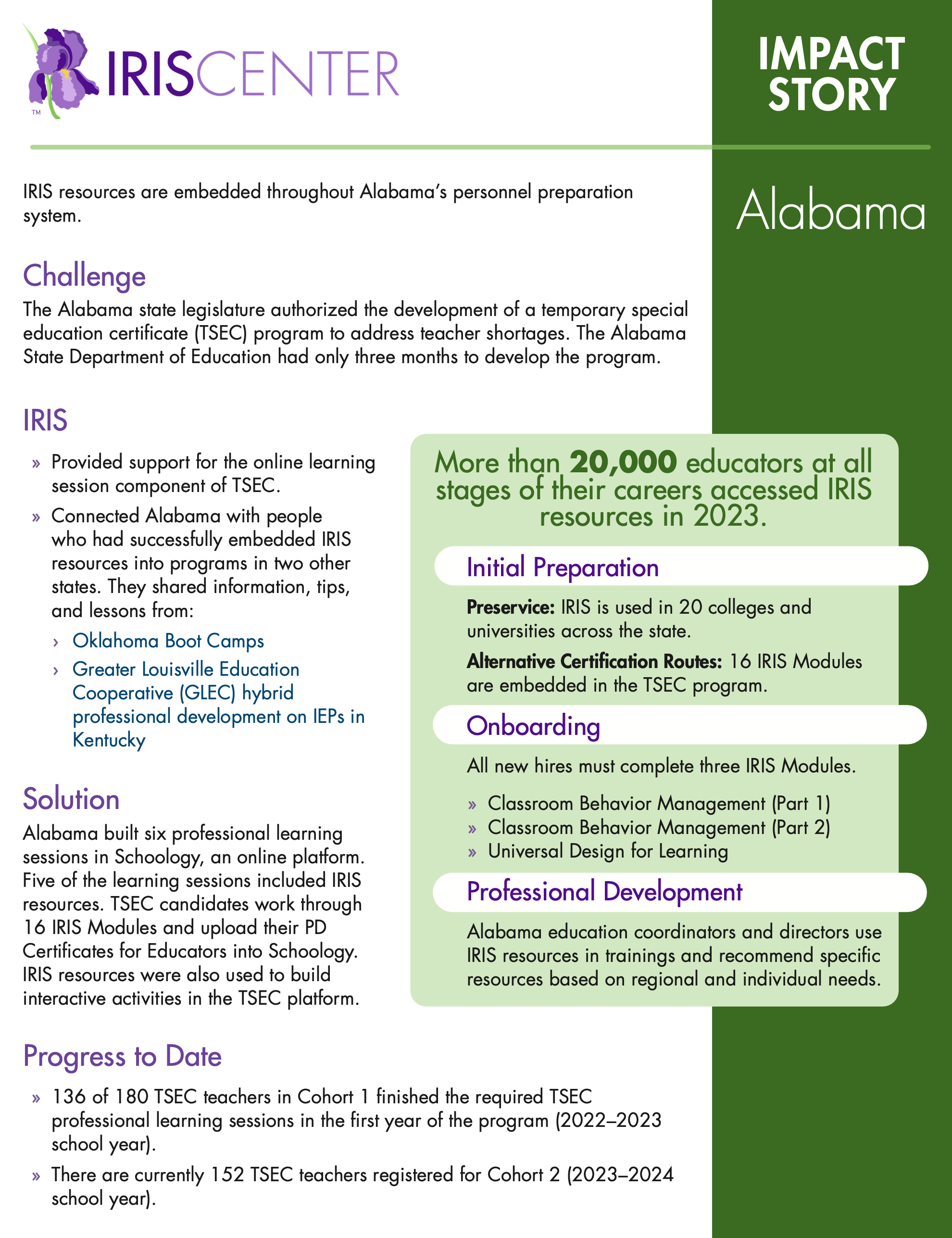IRIS in Alabama: An Alternative Certification Route for Teachers


For quick and easy highlights, view the IRIS Impact Story: Alabama.
IRIS resources are embedded throughout Alabama’s personnel development system, from use in initial preservice preparation programs and alternative certification routes to lifelong learning through ongoing professional development and personalized learning. In fact, over 20,000 educators at all stages of their careers used IRIS resources in 2023. Here are a few examples:
Initial Preparation
- Preservice: IRIS is used in 20 colleges and universities across the state.
- Alternative Certification Routes: Sixteen IRIS Modules are embedded in Alabama’s temporary special education certificate (TSEC) program, which is further explained in the TSEC Initiative section below.
Onboarding
All new hires must complete three IRIS Modules as part of their disproportionality training through the Alabama State Personnel Development Grant (SPDG):
- Classroom Behavior Management (Part 1): Key Concepts and Foundational Practices
- Classroom Behavior Management (Part 2): Developing a Behavior Management Plan
- Universal Design for Learning: Designing Learning Experiences that Engage and Challenge All Students
Professional Development
Alabama education coordinators and directors use IRIS resources in trainings and recommend specific resources based on regional and individual needs.
In this interview, Gwendolyn Preston describes how the use of IRIS resources in Alabama has grown and expanded over the years and how that eventually led to embedding IRIS Modules and other resources into the TSEC program (time: 2:20).

Gwendolyn Preston
Education Specialist
Alabama State Department of Education
Transcript: Gwendolyn Preston
Our partnership with IRIS has been a very popular and well-received opportunity for state teachers and administrators throughout Alabama. We started with an IRIS presentation to school leaders throughout the whole state of Alabama with IRIS resources at our statewide conference, the MEGA Conference, which was held in July, 2021. We also shared IRIS resources at our regional autism trainings in the summers of 2020 and 2021. The IRIS Center presented at a Professional Learning Unit for leadership in special education to our novice coordinators and directors throughout the state of Alabama. This was held in December 2021. We utilize IRIS Center resources over and over again. We always address disproportionality in Alabama schools through training conducted annually for all our newly hired teachers, administrators, and any other staff.
I really think that the presentation that IRIS shared for our MEGA conference, where they showed how the different states were using it, especially one example from Kentucky about how they use the IRIS Modules for that foundational knowledge and the expanding of that specific to their district, that got us started. And I think that was a lot of information, so we tried to do what Oklahoma did, which was using IRIS for those foundational pieces and then thinking about “How does this look here in Alabama?” “How can we build upon this for our situation?” And so that really helped lay the idea for the modules that we’re doing with our TSEC teachers, knowing that we could get these big chunks of foundational pieces that were really high quality. And then our job is to add to that, making it a little bit easier for us. “How does this look for us?” and “How does it look for our students?”
The TSEC Initiative
For more information about the programs in these states, view the following IRIS Stories:
In 2022, the Alabama state legislature authorized the development of the TSEC program to address teacher shortages. The challenge? Education specialists at the Alabama State Department of Education (ALSDE) had only three months to develop the program. The ALSDE, which already had a long history of working with IRIS, reached out for support with this new initiative. IRIS connected them with partners in Oklahoma and Kentucky who had successfully embedded IRIS resources into several programs. These colleagues shared information from their experiences, tips for implementation, and lessons learned.
Based on the information shared by their Oklahoma and Kentucky contacts, Alabama built content in Schoology, an online platform. Five of the six areas for which they built content included IRIS resources (see the TSEC Content Areas and IRIS Modules box for more details). For these content areas, TSEC candidates work through 16 IRIS Modules, then upload their IRIS PD Certificates for Educators into Schoology. IRIS resources were also used to build interactive activities in the TSEC platform.
Alabama’s TSEC program garnered significant interest and participation following its development. During the first year of the program (2022–2023 school year), 136 of the 180 TSEC teachers in Cohort 1 finished the required professional learning sessions. There are currently 152 TSEC teachers enrolled in Cohort 2 (2023–2024 school year).
In this video, Elizabeth Greene, an education specialist in the Alabama State Department of Education, demonstrates how they embedded IRIS resources in Schoology to provide foundational knowledge in key topic areas for their TSEC educators before adding state-specific content (time: 2:23).
Transcript: Utilizing IRIS Resources for Support
So we have six content areas that we’re addressing that these temporary certificate teachers are going to go through over the course of three years, and they include 16 of the IRIS STAR Legacy Modules. We’ve used activities from IRIS in the modules to be self-grading in our learning management system, which is Schoology. So let’s take just a quick look at how we were able to use the IRIS Center within our course.
And so, the first thing that our participants do when they enter our course in the Getting Started, in addition to learning about our course, there is a place for them to learn about the IRIS Center resources, because throughout our training, those participants are going to be completing IRIS STAR Legacy Modules on various topics. And in order to earn credit, they’ll need to get 80% or higher on the posttest and then submit that certificate option.
We have a link here that links straight to the IRIS Center, where they can learn about the PD Certificates, and then we also have a link back again to the IRIS Center for the how-to video that talks about how to complete the certificate.
And so, all that information was already there and available for us to provide more instruction to our teachers.
If we take a quick peek inside one of the modules that we have, again, I said there were six different content areas, and the IRIS Center is that foundational piece for us. Looking at Disability Categories and the Effects of Disabilities, the IRIS Center has several modules on autism. So you see we have some base information here about autism, but with that IRIS Module being the foundation knowledge and the bulk of the knowledge within this section. And this image and the text all comes from the IRIS Center, their description of the course, and then it links straight to where we would have those participants to add this course to their cart. And then they’ll have everything that they need in order to submit that within our course. That’s how they get graded is they’ll make a submission. And so, it makes it self-grading for us. And so, it takes a lot of the heavy workload off of us as we were creating these modules.
Another example of how we used IRIS materials within these modules is taking an IRIS Activity and turning it into a discussion question. All of the content here comes straight from an IRIS Center resource. It’s an activity that they have, and we were able to really quickly turn it into a discussion question so that our participants within our course can discuss cultural sensitivity that they learn through the activity and be able to communicate with each other on that.
Another example of using IRIS resources is in here, where we just have a link that takes you straight to the IRIS website where there is an interview, and we’re able to add that straight into our learning management system.
And so, there’s lots of different ways that we can use these activities. There are so many acronyms in special education, and with our participants coming from outside of education, there’s just a lot to learn. And so, one example here came straight from the IRIS Center website. And then we were able to turn it into a self-grading activity where they’re able to just click and move these pieces so that they’re able to participate in the activity. They’re just quick, little drop boxes. And then, again, that activity becomes self-grading in our learning management system. And so, that takes a lot of the extra effort off of us as we’re trying to manage this for so many teachers.
TSEC Content Areas and IRIS Modules |
Planning and the Learning Environment
|
Development and Characteristics of Learners
|
Instruction
|
Assessment
|
Foundations and Professional Responsibilities
|